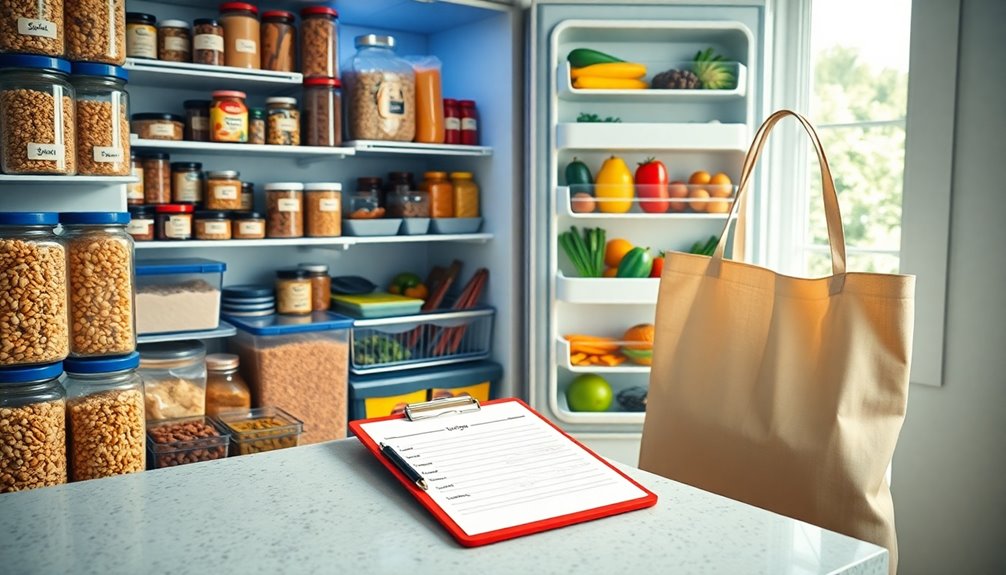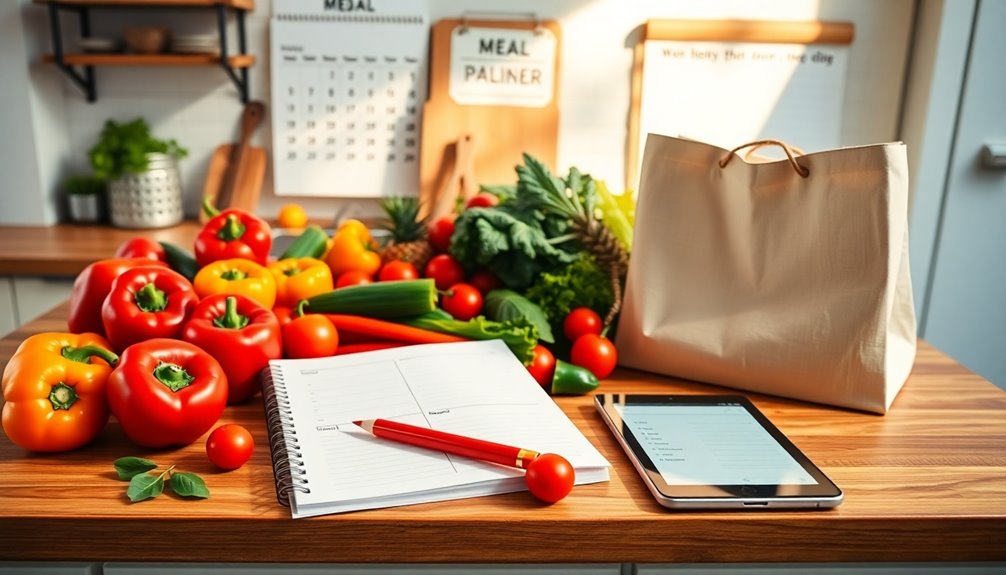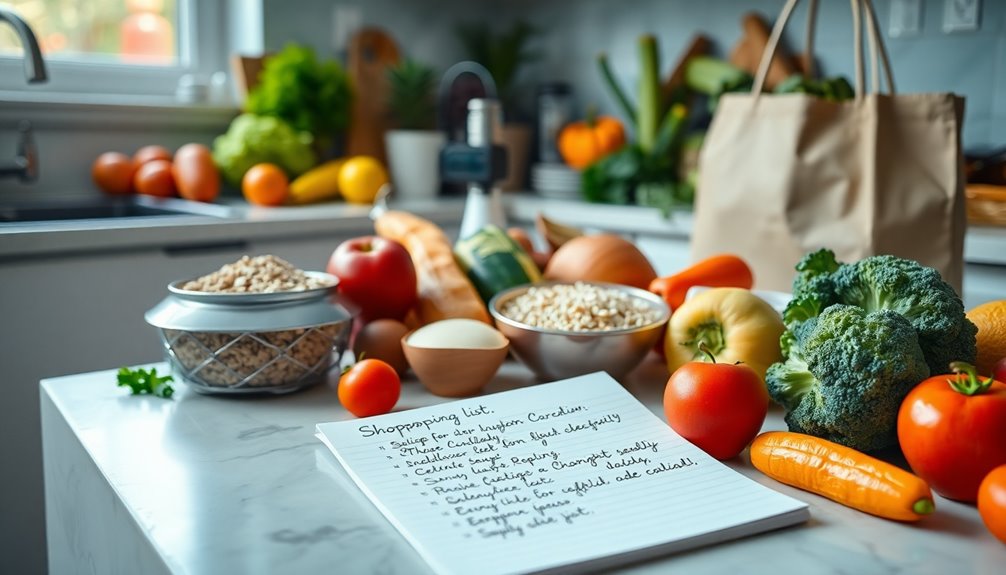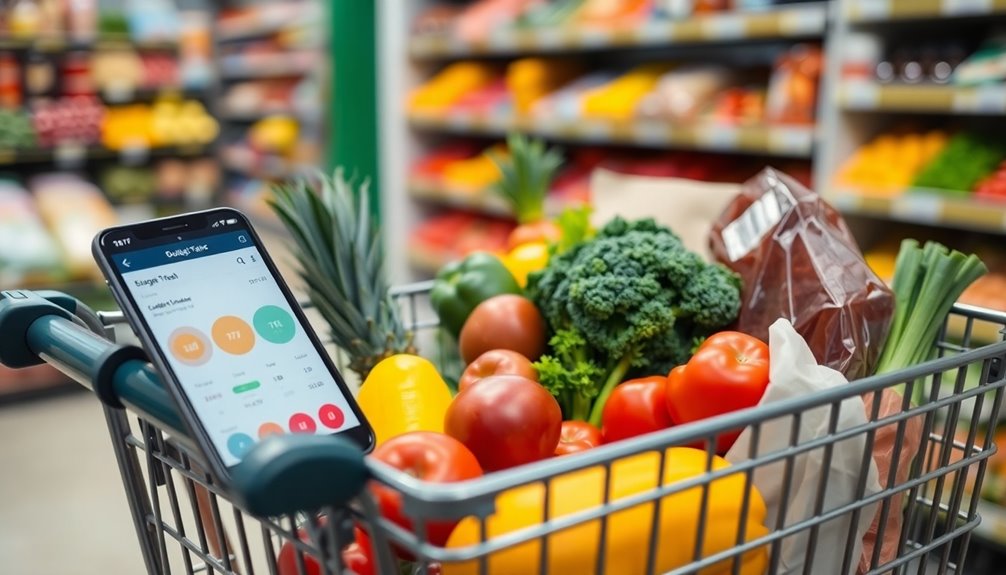To shop smart and avoid overbuying groceries, start by evaluating what's in your pantry and fridge. Plan your meals for the week and create a detailed shopping list based on that. Stick to your budget and avoid impulse buys by focusing only on essentials. Familiarize yourself with store layouts to navigate efficiently, and be cautious of promotions that could tempt you into unnecessary purchases. Shopping without distractions, ideally alone, reduces chances of overbuying. If you implement these strategies, you'll not only save money but also feel more organized. There's much more to discover for smarter shopping habits.
Key Takeaways
- Create a detailed shopping list based on your inventory to avoid unnecessary purchases and stick to essentials.
- Navigate the store efficiently by organizing your list according to store layout, reducing distractions and impulse buys.
- Limit exposure to promotional aisles and be mindful of marketing tactics that may tempt you into buying non-essential items.
- Buy in bulk for frequently used items to save money, but only if you can use them before they expire.
- Avoid shopping when hungry and consider going alone to minimize distractions and enhance focus on your list.
Assess Your Pantry and Fridge

Regularly evaluating your pantry and fridge is essential for efficient grocery shopping. It's not just about saving money; it's about creating a space that feels organized and inviting. Start by checking expiration dates on all your items. You might be surprised at how many things have quietly expired, waiting for your attention. Toss anything that's past its prime to make room for fresh ingredients that will inspire your cooking.
Next, take a good look at what you already have. It's easy to forget what's hiding in the back of the pantry or fridge, leading to unnecessary duplicates. By identifying what you've got, you can avoid buying more of the same item. This not only saves you money but also helps prevent food waste, allowing you to feel more connected to your community and the environment.
Consider creating a simple inventory list of your staples and perishables. This way, you'll know exactly what you need before heading to the store. An organized pantry and fridge don't just streamline your shopping; they also encourage creativity in the kitchen. Additionally, having a well-stocked pantry with plant-based staples can inspire you to experiment with new vegan recipes.
You'll find it easier to whip up meals with the ingredients you already have, fostering a sense of accomplishment and belonging in your cooking journey.
Plan Your Meals Ahead

Meal planning transforms your grocery shopping experience from chaotic to intentional. By taking the time to map out your meals for the week, you'll not only reduce impulse purchases but also cultivate a sense of belonging through shared meals with family and friends. Start by gathering recipe inspiration that excites you—think seasonal ingredients or family favorites. This way, you'll look forward to cooking instead of viewing it as a chore.
As you create your meal plan, consider portion control. This helps minimize waste and guarantees everyone gets a satisfying meal without overdoing it. You might choose to cook larger batches of a dish and enjoy leftovers for lunch, which saves time and cuts down on the need for extra groceries.
Don't forget to mix things up! Incorporating a variety of recipes keeps meals interesting and encourages you to explore new cuisines. You can even involve your family in the planning process, asking for their input on what they'd like to eat. This not only strengthens bonds but also ensures that everyone feels included.
Meal planning doesn't have to be complex; it can be as simple as jotting down ideas for breakfast, lunch, and dinner. By investing a little time upfront, you'll find that your grocery shopping becomes more focused and efficient. You'll feel empowered knowing exactly what you need and how to prepare it, fostering a sense of community around the dinner table. Additionally, research has shown that meal planning can help manage blood sugar levels, which is essential for those with diabetes.
Create a Detailed Shopping List

After you've mapped out your meals for the week, it's time to compile a detailed shopping list that aligns with your plan. A well-organized list not only helps you stay on track but also significantly decreases the chances of overbuying and wasting food. One of the best ways to create your list is by categorizing items according to sections of the store. This method can assist you in avoiding impulsive purchases, making your shopping experience smoother and more efficient.
Here's a sample layout for your shopping list:
| Category | Item | Price Range |
|---|---|---|
| Produce | Apples | $0.50 – $2.00 |
| Dairy | Milk | $2.00 – $4.00 |
| Grains | Rice | $1.00 – $3.00 |
| Proteins | Chicken Breast | $4.00 – $10.00 |
Before you head out, make sure to compare prices at different stores or online. You might find that your usual grocery store doesn't always offer the best deals. By doing this, you'll not only save money but also feel like a smart shopper. Remember, a detailed shopping list empowers you to stick to your meal plan, avoids those pesky impulse buys, and creates a sense of belonging to a community that values intelligent shopping. Additionally, honing your skills in hand sharpening can provide a rewarding feeling of accomplishment when preparing meals. Happy shopping!
Stick to Your Budget

Sticking to your budget is crucial for smart grocery shopping and helps prevent unnecessary financial strain. By managing your spending, you can better enjoy your meals and feel more at ease about your finances. Here's how to stay on track:
- Prioritize essentials: Focus on the items you truly need. Fresh produce, grains, and proteins should be your top priority. This guarantees you cover the basics without overspending on extras.
- Set a spending limit: Before you head to the store, decide on a budget that's realistic yet firm. Having a clear financial boundary makes it simpler to make informed choices as you shop.
- Keep track of your total: As you fill your cart, keep a running tally of your expenses. This helps you stay conscious of how much you've spent and reminds you to stick to your budget.
- Avoid temptations: It can be easy to get sidetracked by sales and flashy displays. Stay focused on your list and resist the urge to buy items that aren't part of your essentials. Additionally, consider incorporating whole food sources of protein into your meals as they can help enhance energy levels while keeping your budget in check.
Understand Store Layouts

Understanding store layouts can make a significant difference in your grocery shopping experience. When you know how a store organizes its products, you can navigate it more efficiently and avoid those pesky distractions that often lead to overbuying. Take a moment to familiarize yourself with where your favorite items are located.
Most stores place essentials like dairy and produce at the back; this design encourages you to walk through aisles filled with tempting snacks and impulse buys.
To maximize your shopping trip, create a list based on the store's layout. This strategy helps you stay focused on what you need, minimizing the chance of getting sidetracked by eye-catching displays. While you might think a quick detour is harmless, those distractions can quickly add unnecessary items to your cart.
When you enter the store, stick to your plan. Efficient navigation not only saves you time but also keeps your budget in check. Consider using a shopping app that allows you to map out your route based on your list, making it even easier to find everything you need without wandering aimlessly.
Be Mindful of Promotions

When you spot a promotion or sale, it's easy to get excited and fill your cart with items you mightn't really need. Those flashy discounts can lead to promotion pitfalls, causing you to make impulse buys that don't fit your shopping list or budget. To shop smart, keep these tips in mind:
- Stick to Your List: Before heading to the store, create a grocery list and adhere to it. This helps you focus on what you actually need rather than what's on sale.
- Evaluate the Need: Ask yourself if you'll actually use the promoted item. Just because it's on sale doesn't mean you should buy it. Consider whether it'll go to waste or sit in your pantry.
- Compare Prices: Sometimes, the "sale" price isn't as good as it seems. Check unit prices to make sure you're getting the best deal possible, not just a temporary discount.
- Limit Your Exposure: If you find that promotions lead to impulse buys, consider avoiding the aisles that feature them. This can help reduce temptation and keep your cart focused on essentials.
Additionally, adopting a plant-based diet can help you save money on groceries while making healthier choices.
Frequently Asked Questions
How Can I Avoid Impulse Buys at the Store?
To avoid impulse buys at the store, start by creating a budget that outlines how much you can spend.
Next, make a list of the items you actually need, and stick to it while shopping.
This focused approach helps you resist distractions and keeps your spending in check.
Should I Shop Alone or Bring Someone With Me?
When deciding whether to shop alone or bring someone along, consider your shopping buddies' influence. Shopping with a friend can help keep you accountable and make the experience more enjoyable. They can offer suggestions and support, reducing the likelihood of impulse buys.
However, solo shopping allows you to focus solely on your list without distractions. Weigh the pros and cons, and choose what fits your style and shopping goals best.
What Are the Best Times to Grocery Shop?
Shopping savvy starts with selecting smart times! Early mornings or late evenings are ideal; stores are less crowded, making it easier to stick to your budgeting tips.
Plus, planning meals beforehand guarantees you grab only what you need, reducing impulse buys.
You'll feel a sense of community as you navigate the aisles, knowing you're making practical choices that benefit both your wallet and your well-being.
Happy shopping!
How Do I Store Leftovers to Prevent Waste?
To store leftovers and prevent waste, practice meal prep and portion control. Start by dividing your leftovers into individual servings, which makes it easier to grab when you're hungry.
Use airtight containers to keep food fresh and avoid spills. Label each container with the date to guarantee you consume everything in a timely manner.
Are There Apps to Help Manage My Grocery List?
Yes, there are plenty of apps to help you manage your grocery list effectively. Many of these apps include features for meal planning, so you can plan your meals ahead and only buy what you need. Plus, they often have budget tracking to keep your spending in check.
Conclusion
By taking the time to assess your pantry and plan your meals, you're not just avoiding waste; you're embracing a smarter way to shop. Creating a detailed list can feel tedious, yet it saves you from overspending in the long run. While store promotions might tempt you to buy more, sticking to your budget empowers you to make informed choices. Ultimately, shopping smart transforms your grocery trips from chaotic to efficient, ensuring you only buy what you truly need.



